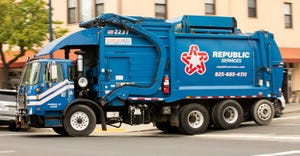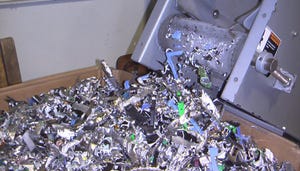The Deconstruction Of C&D Waste: Nailing Down The Numbers
June 1, 1994
Del Freeman
The improved economy and accompanying new construction, paired with the hurricanes, tornadoes and floods that have plagued the country in the last couple of years, have meant an explosion of business for construction and demolition (C&D) haulers and handlers.
Because C&D waste has a reputation for being easy to dispose, it has escaped much of the rigid regulation surrounding other wastes. Handlers agree that, aside from its bulk, which tends to complicate handling, C&D waste is probably the least difficult waste stream to recycle, burn or bury. While source separation can be a problem due to the mixed content of C&D waste, much of it, industry insiders agree, is readily recyclable. And new methods of converting materials to other uses are being developed, guaranteeing an even greater recycling effort in the future.
Thought to account for some 32 million tons of the entire yearly national waste stream, C&D waste is catching the eye of the U.S. Congress and a slew of environmentalists who want to know exactly what it is and where it's going. Many C&D haulers and handlers are beginning to wonder how any resultant legislation may affect their industry down the road.
But since C&D generation is prolific, companies such as Think Pink Inc., Birmingham, Ala., continue to spring up to handle its disposal. Sisters Rebecca Hickel and Marsha Kinard, operators of the company, entered the C&D disposal business about five years ago.
"We only deal in debris. We have our own landfill and don't dump at the county or city," Hickel said. She and her sister launched the business at the urging of their father, whose 35-year demolition career convinced him of the need.
Think Pink Inc. has recently been involved in the construction of an airport expansion and a civic center in Birmingham, and is currently active in hauling debris from the construction site of the area's largest high school. The sisters strictly regulate the content of the C&D waste they landfill, Hickel said, and do not accept asbestos or any material containing lead.
Despite their company's recent involvement with construction hauling, Hickel believes the greatest portion of C&D waste is generated in demolition. But she, like many others involved in C&D disposal, has no figures on how much is disposed on a regular basis at her landfill.
Clear data on the amount of C&D waste that is generated and disposed nationally is an even greater mystery.
While some studies have indicated that approximately 32 million tons of C&D waste is landfilled each year, those figures and the data on which they are based may be outdated.
According to Allen Blakey of Environmental Industry Associations (EIA), an Environmental Protection Agency report to Congress in 1988 indicated that an estimated 31.5 million tons of C&D waste are generated every year. This estimate represents approximately 22 percent of the entire solid waste stream disposed in 1986.
Due to the lack of tracking being done on C&D waste, most experts can only offer educated guesses that, while demolition generates a large amount of C&D waste at one site (see Table 2 on page 38), the bulk of C&D waste comes from construction (see Table 1 on page 36).
The Metropolitan Area Solid Waste Agency, Des Moines, Iowa, has been tracking C&D waste locally and has determined that it comprises less than 10 percent of the total waste stream, according to the agency's Kevin Officer.
"We have a lot of homes being constructed in this area," said Officer, "so I'd say currently housing construction is the biggest generator of C&D waste, both on a volume and tonnage basis."
Although C&D waste represents a relatively low percentage of total waste, Des Moines is trying to deal with the issue of its disposal, Officer said. The city must reduce the amount of C&D waste that it landfills by 50 percent before 2000.
Recycling The Rubble Most industry officials agree that few problems can be associated with disposing C&D waste. The materials are being recycled, landfilled and incinerated "pretty easily," said Blakey of EIA.
"There are fewer inherent problems in C&D waste disposal because it's fairly uniform stuff and fairly inert, primarily dirt, wood, concrete and metal," Blakey said.
The most important issue with C&D disposal, said Officer, is to encourage the industry to recycle. "Although some portion will always have to be disposed, some C&D waste components are readily recyclable and reusable," he said. The natural content of C&D waste, he said, makes recycling a viable disposal method.
Officer feels that there is little concern about the potentially hazardous content of C&D waste. "For instance, formaldehyde is used to put pressed board together - that may be a concern environmentally, but I haven't found any," he said.
"The majority of the waste seems to be of the organic, inert nature as far as containment of hazardous materials," said Officer.
But a variety of potentially hazardous materials can exist in C&D waste, according to "Construction and Demolition Waste," a public service report conducted by the University of Illinois at Chicago in January 1993.
The report lists more than 60 possible components in C&D waste that may be hazardous contaminants, from acetone to waterproofing agents.
Only a close, onsite monitoring of the C&D waste being hauled into landfills would provide control over the inclusion of such agents, but industry insiders agree that the risk of potential contaminants is minimal. Asbestos can be landfilled in a separate area following bagging, and formaldehyde will evaporate. None-theless, C&D waste is not of a nature to decay, and will continue to occupy landfill space by virtue of its size and quantity.
"What I've found in this area is that a lot of the waste stream seems to be scrap wood, cardboard, concrete and some, but very little, asphalt and roofing shingles," said Officer. Much of that material is already being recycled.
Separation is a component in effective recycling that Officer sees as the next step in effective disposal of C&D waste. "It's just a pile of mixed wood, drywall and concrete - anything that a building is made of is in that waste stream," Officer said. It is not a stream that lends itself to source separation in its current handling, he added, and the first problem is finding a method of source separation.
"One alternative is to separate C&D waste material at the source site, and the other is to continue doing what we're doing," he said. Currently, any separation is done at a recycling facility, but scarcity of such facilities and the cost to construct additional facilities are drawbacks in solving the problem, he said.
Implementing and enforcing controls on C&D waste, however, may be problematic. "We are not a regulatory body," Officer said, "and the only mandates are on the landfill itself." Enforcement is limited by placing a ban on acceptable materials and calling on builders to designate the type load which is being hauled, he said.
Many companies are investigating alternative uses for C&D waste. For example, Browning-Ferris Industries (BFI) has begun taking wooden pallets found in C&D debris and chipping them into decorative mulch, said Richard Oakley, regional vice president of landfill operation at BFI. Other firms are grinding concrete rubble down to make second-hand aggregate for stone and road-building materials.
Two additional C&D studies currently are underway, including a study in Des Moines and a project in Babylon, N.Y. The Des Moines study will include the development and demonstration of current tracking and disposal methods, as well as a composition analysis of materials generated from C&D projects.
Answering these and other questions about C&D waste may help develop better systems for hauling and disposal in the future. But some handlers fear that C&D waste, like other waste categories, will fall subject to a multitude of rules and regulations that will permanently affect the industry.
You May Also Like


